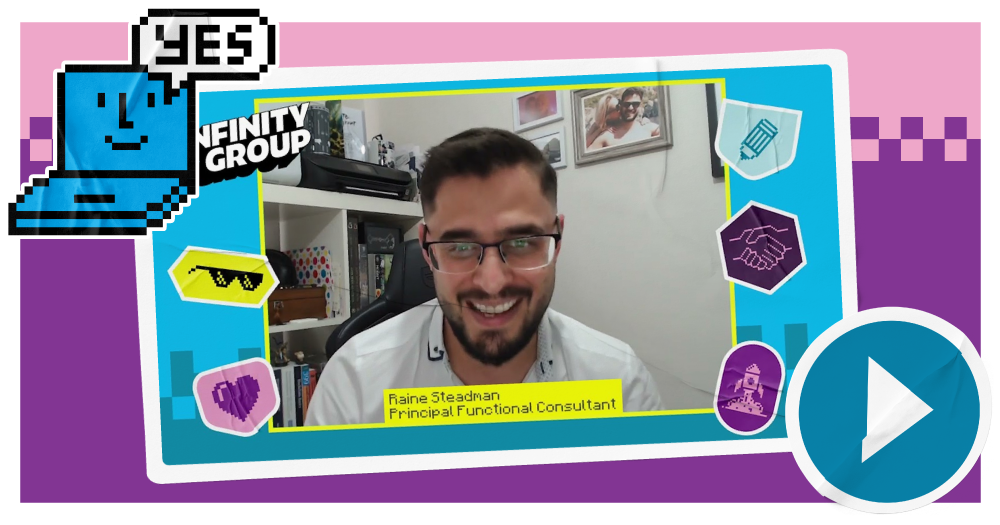When it comes to bringing our clients’ visions to life, we know collaboration is key. Every project we work on at Infinity Group is upheld by a strong working relationship with client-side architects to ensure long-term success.
Our ethos is creating solutions that empower our clients to achieve their goals, backed by our support. This is in sync with Microsoft’s approach to their solutions.
When it comes to Power Platform projects, clients receive ongoing support from both Infinity Group and Microsoft throughout the lifecycle of their solutions. The solutions provided must adapt with the client, which means deeply understanding objectives throughout the project.
Raine Steadman, Principal Functional Consultant at Infinity Group, talks about how we collaborate with our clients on Power Platform projects and the results this approach brings.
How do we use collaboration to leverage the full potential of the Power Platform?
We believe that open communication establishes transparent and consistent communication channels to share insights, progress and challenges. As a supplier, we form a single team with our client, and we share the successes and failures as one.
We start implementing this through collaborative workshops that offer an opportunity to explore Power Platform capabilities. These also uncover what the business and end users expect, which shapes the delivery of the project.
In the early stages, we also share access to educational materials and training on the Power Platform’s features and sideline development tools. The more everyone knows and understands, the easier it is to foster collaboration and clear communication. It creates an environment that supports experimentation with the platform’s features to discover new solutions together.
From there, we can ensure a unified vision. This aligns everyone on common objectives and outcomes to ensure both parties are working towards the same goals.
What are effective strategies for aligning the shared goals of a project with the capabilities and services offered by the Power Platform?
Goal capability mapping is the number one priority ahead of any Power Platform project. Identify project goals and map them to specific Power Platform services that can achieve them.
We also aim to identify gaps in Power Platform offerings and agree on how custom development and other technologies can be used to cater to these gaps.
Another strategy we leverage is incremental implementation. We start with a small-scale implementation to demonstrate value and gradually expand usage. Infinity Group tends to follow an agile methodology to deliver functionality quickly, whilst giving the customer the chance to revise and change things they need or do not like.
We also rely on cross-functional collaboration. We seek to engage stakeholders from different areas to ensure the platform meets diverse needs. Infinity Group provides updates to the customer, providing knowledge on new features that may be of benefit to them, and advises them of best practice. This can then be shared across the client team.
How can consultants use Power Platform and DevOps to enhance the skills of client-side architects in low-code and high-code solutions?
As consultants, we use Power Platform and DevOps to enhance the skills development of clients and architects in the following ways:
- Integrated learning: We combine Power Platform’s low code capabilities with DevOps practices in line with Infinity Group’s best standards of practice. This allows us to leverage both technologies to learn more and drive value.
- Agile development: We apply DevOps methodologies to iterate quickly and improve solutions using Power Platform.
- Cross-disciplinary expertise: We encourage understanding of both low-code and high-code environments for versatile skill growth. Infinity Group typically has a varied team of resources, with experts in low-code and high-code.
- Feedback loops: We use retrospectives at the end of each sprint to refine Power Platform solutions and foster ongoing learning.
Infinity Group has development standards that keep all custom development managed in a way that makes it easy for us to use and for the client to pick it up and run with it in the future. By integrating these approaches, consultants can help client-side architects develop a robust set of skills applicable to various solution architectures.
What metrics can be used to assess the success of a partnership focused on building solutions within the Power Platform?
There are a number of KPIs we use to track the success of a Power Platform solution once live. These include:
- Adoption rates: Track how widely and quickly Power Platform solutions are being utilised through a series of reports.
- User satisfaction: Conduct surveys to gauge user satisfaction with the solutions. We ask the hard questions and respect the truth of the end user and management teams. Remember, it’s all about success through incremental changes and working together to deliver those changes to the business.
- Performance improvements: Measure enhancements in processes where Power Platform solutions are implemented. We use process mining through Power Automate to measure the as-is state and compare it against the to-be state to see improvements.
- Return on investment: Calculate the financial impact by comparing the cost saved or revenue generated against the development and implementation expenses. We utilise DevOps to estimate development times, and use Power Automate to show the time saved.
These metrics help determine if the partnership is achieving its goals in terms of efficiency, cost savings, user engagement and overall success.
What challenges might arise when integrating client-side developers into a project, and how can these be mitigated?
There are a few obstacles we see crop up when working with client-side developers. These include:
- Communication barriers: Ensuring clear understanding across teams with different backgrounds, languages and locations.
- Coding standards: Aligning code quality and style with project guidelines. Different team members may have different naming conventions or coding styles, which can create friction.
- Version control: Managing code contributions to avoid conflicts, especially when multiple developers are working on the same solutions simultaneously.
- Requirement clarity: Both the client and supplier must clearly understand what is being delivered to avoid misunderstandings.
To mitigate these challenges, we establish guidelines, use version control tools, hold regular meetings and conduct code reviews. These strategies help smooth the integration process and ensure successful collaboration between client-side architects and Infinity Group architects.
How does an understanding of Microsoft’s principles, such as security and compliance, impact the collaboration between consultants and client-side architects?
An understanding of Microsoft principles, particularly security and compliance, can significantly impact collaboration in the following ways:
- Enhance trust: Knowledge of security and compliance builds trust, ensuring the collaboration adheres to industry standards.
- Efficient communication: A shared understanding facilitates smooth communication, with both parties using the same terminology regarding security measures and compliance regulations.
- Effective planning: Early planning around these principles can mitigate potential risks, reducing the need for costly revisions later in the project lifecycle.
- Alignment on standards: Ensuring system design and implementation are aligned with legal requirements and best practices set by both the supplier and the customer.
How do you consult and support client-side resources in staying current with the evolving landscape of the Power Platform and Microsoft technologies?
As consultants, we support client-side resources in staying current through continued education, offering workshops, webinars and training sessions on the latest features.
We also share Microsoft’s roadmap of events and encourage participation in forums, user groups and conferences, as well as our own Infinity Group events. We provide access to up-to-date documentation, best practices and case studies.
Additionally, we give you complete access to your code, so you can see what we’re doing, when we’re doing it, who did it and why. We’ll also give tailored advice on how to use new capabilities in your specific context.
These efforts help ensure that client-side resources are well-equipped to leverage the full potential of Microsoft’s offerings.
What tools do you use on a Power Platform project?
We use a range of tools to bring client visions to life and ensure successful Power Platform deployments. These include:
- Azure DevOps: Used to manage your entire backlog of requirements, for source controlling our code, and for planning projects, including sprints, requirements, bugs and resource assignments.
- Microsoft Teams: Essential for collaboration and communication. We set up group chats with project stakeholders and share documentation that sits outside of Azure DevOps.
- Microsoft Office applications: Commonly used, along with Visio for mapping out current business process flows and advising on platform adjustments for quick wins and long-term goals.
- Power BI: Used for reporting adoption rates and more.
- Visual Studio: Used by our technical consultants for custom developments requiring JavaScript, TypeScript, React, C# and more.
- VS Code: Assists with custom developments, JavaScript and deployments.
- SSM Toolbox: A lifesaver for Dynamics projects, saving significant time.
Infinity Group also partners with an extensive group of suppliers, known as ISVs (Integrated Software Vendors) or for third-party integrations. We work with these partners to provide tools for tasks like e-signing and template design.
Lastly, Infinity Group has its own intellectual property, which has been custom-built and works for multiple customers. This can be made available on a monthly or annual subscription model.
Next steps
If you want to bring Power Platform into your business to address the challenges you’re facing or drive innovation, we’ll guide you to success.
Our experienced consultant will work alongside your project team to understand your goals and create a solution that truly fits your needs.




